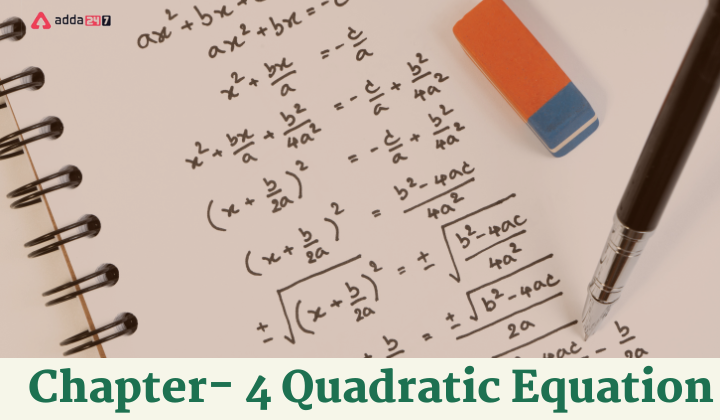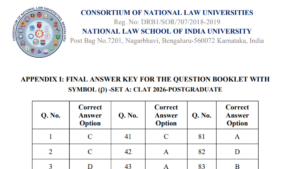Quadratic Equation Class 10- Definition
- A quadratic equation in the variable x is an equation of ax2+bx+c=0, where a,b, and c are real numbers, a≠0.
- For example, 2×2+x−300=0 is a quadratic equation.
Quadratic Equation Class 10- Standard Form
- Any equation of the form p(x)=0, where p(x) is a polynomial of degree 2, is a quadratic equation.
- But when we write the terms of p(x) in descending order of their degrees, we get the equation’s standard form.
- That is, ax2+bx+c=0, a≠0 is called the standard form of a quadratic equation.
Quadratic Equation Class 10- Roots
- A solution of the equation p(x)=ax2+bx+c=0, with a≠0, is called a root of the quadratic equation.
- A real number α is called a root of the quadratic equation ax2+bx+c=0,a≠0 if aα2+bα+c=0.
- It means x=α satisfies the quadratic equation or x=α is the root of the quadratic equation.
- The zeroes of the quadratic polynomial ax2+bx+c and the roots of the quadratic equation ax2+bx+c=0 are the same.
Ace your class 10th board exams with Adda247 live classes for class 10th preparation.
Quadratic Equation Class 10- Method Of Solving
1. Factorisation Method
- Factorise the quadratic equation by splitting the middle term.
- After splitting the middle term, convert the equation into linear factors by taking common terms out.
- Then, on equating each factor to zero, the roots are determined.
For example:
⇒2×2−5x+3 (Split the middle term)
⇒2×2−2x−3x+3 (Take out common terms to determine linear factors)
⇒2x(x−1)−3(x−1)
⇒(x−1)(2x−3) (Equate to zero)\
⇒(x−1)(2x−3)=0
When (x−1)=0 , x=1
When (2x−3)=0 , x=32
So, the roots of 2×2−5x+3 are 1 and 32
2. Method Of Completing The Square
- The solution of a quadratic equation can be found by converting any quadratic equation to the perfect square of the form (x+a)2−b2=0.
- To convert quadratic equation x2+ax+b=0 to perfect square equate b, i.e., the constant term to the right side of the equal sign, then add a square of half of an, i.e., square of half of the coefficient of x on both sides.
- To convert the quadratic equation of form ax2+bx+c=0, a≠0 to perfect square, first divide the equation by an, i.e., the coefficient of x2, then follow the above-mentioned steps.
For example:
⇒x2+4x−5=0 (Equate constant term 5 to the right of the equal sign)
⇒x2+4x=5 (Add a square of half of 4 on both sides)
⇒x2+4x+(42)2=5+(42)2
⇒x2+4x+4=9
⇒(x+2)2=9
⇒(x+2)2−(3)2=0
It is of the form (x+a)2−b2=0
Now,
⇒(x+2)2−(3)2=0
⇒(x+2)2=9
⇒(x+2)=±3
⇒x=1
and x=−5
So, the roots of x2+4x−5=0are 1 and −5
3. By using the quadratic formula
The root of a quadratic equation ax2+bx+c=0 is given by the formula
x=−b±b2−4ac−−−−−−−√2a, where b2−4ac−−−−−−−√ is known as a discriminant.
If b2−4ac−−−−−−−√≥0, then only the root of a quadratic equation is given by
x=−b±b2−4ac−−−−−−−√2a
For example:
⇒x2+4x+3
By using the quadratic formula, we get
⇒x=−4±(4)2−4×1×3−−−−−−−−−−−−−√2×1
⇒x=−4±16−12−−−−−−√2
⇒x=−4±4–√2
⇒x=−4±22
⇒x=−4+22, x=−1
⇒x=−4−22,x=−3
So, the roots of x2+4x+3=0 are −1 and −3
Quadratic Equation Class 10- Nature Of Roots Based On Discriminant
- If b2−4ac−−−−−−−√=0, then the roots are real and equal
- If b2−4ac−−−−−−−√>0, then the roots are real and distinct.
- If b2−4ac−−−−−−−√<0then the roots are imaginary
Learn more about Quadratic Equations
Quadratic Equation Class 10- Sample Questions with Answers
Ques. What will be the nature of the roots of the quadratic equation 2×2 + 4x – n = 0?
Solution: D = b2 – 4ac
⇒ 42 – 4 x 2 (-7)
⇒ 16 + 56 = 72 > 0
Hence, the roots of a quadratic equation are real and unequal.
Ques. If -5 is a root of the quadratic equation 2×2 + px – 15 = 0 and the quadratic equation p(x2 + x) + k = 0 has equal roots, then find the value of k.
Solution: Since – 5 is a root of the equation 2×2 + px – 15 = 0
∴ 2(-5)2 + p(-5) – 15 = 0
⇒ 50 – 5p – 15 = 0 or 5p = 35 or p = 7
Again p(x2 + x) + k = 0 or 7×2 + 7x + k = 0 has equal roots
∴ D = 0
i.e., b2 – 4ac = 0 or 49- 4 × 7k = 0
⇒ k = 4928 = 74
Ques. Find the values of k for each of the following quadratic equations so that they have two equal roots.
(i) 2×2 + kx + 3 = 0
(ii) kx (x – 2) + 6 = 0
Solution: (i) We have, 2×2 + kx + 3 = 0
Here, a = 2, b = k, c = 3
D = b2 – 4ac = k2 – 4 × 2 × 3 = k2 – 24 For equal roots
D = 0
i.e., k2 – 24 = 0
⇒ ķ2 = 24
⇒ k = ± √24
⇒ k = + 2√6
(ii) We have, kx(x – 2) + 6 = 0
⇒ kx2 – 2kx + 6 = 0
Here, a = k, b = – 2k, c = 6
For equal roots, we have
D = 0
i.e., b2 – 4ac = 0
⇒ (-2k)2 – 4 × k × 6 = 0
⇒ 4k2 – 24k = 0
⇒ 4k (k – 6) = 0
Either 4k = 0 or k – 6 = 0
⇒ k = 0 or k = 6
But k = 0 6)ecause if k = 0 then given equation will not be a quadratic equation).
So, k = 6.
Ques. If the equation (1 + m2)x2 + 2mcx + c2– a2 = 0 has equal roots, show that c2 = a2 (1 + m2).
Solution: The given equation is (1 + m2) x2 + (2mc) x + (c2– a2) = 0
Here, A = 1 + m2, B = 2mc and C = c2 – a2
Since the given equation has equal roots, therefore D = 0 = B2 – 4AC = 0.
⇒ (2mc)2 – 4(1 + m2) (c2 – a2) = 0
⇒ 4m2c2 – 4(c2 – a2 + m2c2 – m2a2) = 0
⇒ m2c2 – c2 + a2 – m2c2 + m2a2 = 0. [Dividing throughout by 4]
⇒ – c2 + a2 (1 + m2) = 0
⇒ c2 = a(1 + m2) Hence Proved
Ques. If the roots of the quadratic equation (x – a) (x – b) + (x – b) (x – c) + (x – c) (x – a) = 0 are equal, then show that a = b = c.
Solution: Given (x – a) (x – b) + (x – b) (x – c) + (x – 6) (x – a) = 0
⇒ x2 – ax – bx + ab + x2 – bx – cx + bc + x2 – cx – ax + ac = 0
⇒ 3×2 – 2(a + b + c)x + ab + bc + ca = 0
Now, for equal roots D = 0
⇒ B2 – 4AC = 0
⇒ 4(a + b + c)2 – 12(ab + bc + ca) = 0
4a2 + 4b2 + 4c2 + 8ab + 8bc + 8ca – 12ab – 12bc – 12ca = 0
⇒ 2[2a2 + 2b2 + 2co – 2ab – 2bc – 2ca] = 0
⇒ 2[(a2 + b2 – 2ab) + (b2 + c2 – 2bc) + (c2 + a2 – 2ca)] = 0
⇒ [(a – b)2 + (b – c)2 + (c – a)2] = 0
⇒ a – b = 0, b – c = 0, c – a = 0
⇒ a = b, b = c, c = a
⇒ a = b = c
Ques. In a class test, the sum of Shefali’s marks in Mathematics and English is 30. Had she got 2 marks more in Mathematics and 3 marks less in English, the product of her marks would have been 210. Find her marks in the two subjects.
Solution: Let Shefali’s marks in Mathematics be x.
Therefore, Shefali’s marks in English are (30 – x).
Now, according to the question,
⇒ (x + 2) (30 – x – 3) = 210
⇒ (x + 2) (27 – x) = 210
⇒ 27x – x2 + 54 – 2x = 210
⇒ 25x – x2 + 54 – 210 = 0
⇒ 25x – x2 – 156 = 0
⇒ -(x2 – 25x + 156) = 0
⇒ x2 – 25x + 156 = 0
= x2 – 13x – 12x + 156 = 0
⇒ x(x – 13) – 12(x – 13) = 0
⇒ (x – 13) (x – 12) = 0
Either x – 13 or x – 12 = 0
∴ x = 13 or x = 12
Therefore, Shefali’s marks in Mathematics = 13
Marks in English = 30 – 13 = 17
or Shefali’s marks in Mathematics = 12
marks in English = 30 – 12 = 18.
Ques. The sum of the areas of two squares is 468 m2. If the difference in their perimeters is 24 m, find the sides of the two squares.
Solution: Let x be the length of the side of the first square and y be the length of the side of the second square.
Then, x2 + y2 = 468 …(i)
Let x be the length of the side of the bigger square.
4x – 4y = 24
⇒ x – y = 6 or x = y + 6 …(ii)
Putting the value of x in terms of y from equation (ii), in equation (i), we get
(y + 6)2 + y2 = 468
⇒ y2 + 12y + 36 + y2 = 468 or 232 + 12y – 432 = 0
⇒ y2 + 6y – 216 = 0
⇒ y2 + 18y – 12y – 216 = 0
⇒ y(y + 18) – 12(y + 18) = 0
⇒ (y + 18)(y – 12) = 0
Either y + 18 = 0 or y – 12 = 0
⇒ y = -18 or y = 12
But, sides cannot be negative, so y = 12
Therefore, x = 12 + 6 = 18
Hence, the sides of the two squares are 18 m and 12 m.











 When Will NEET 2026 Registration Start? ...
When Will NEET 2026 Registration Start? ...
 UP NEET UG Counselling 2025 Round 5 Meri...
UP NEET UG Counselling 2025 Round 5 Meri...
 CLAT 2026 Final Answer key Out, Download...
CLAT 2026 Final Answer key Out, Download...






